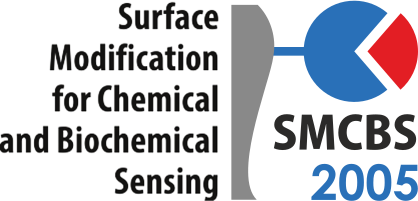2nd International Workshop on Surface Modification for Chemical and Biochemical Sensing
About
The present booklet contains programme and abstracts of invited tutorial lectures, as well as contributed keynote lectures, short oral communications, and posters of the 2nd International Workshop on 'Surface Modification for Chemical and Biochemical Sensing', SMCBS'2005. We are pleased and feel honoured to host over a dozen of distinguished scientists who have kindly accepted our invitation to present tutorial lectures.
This Workshop is organized as a part of the activity of the Centre of Excellence 'Surface Phenomena and Reactions' (SURPHARE) established within the 6th Frame Programme of the European Commission at the Institute of Physical Chemistry of the Polish Academy of Sciences in Warsaw, Poland.
Interdisciplinary between chemistry, biochemistry, molecular biology, physics, materials science, microelectronics, and en- gineering has created important new ideas in several research fields including sensing and biosensing. For sensing, surfaces of solid substrates of chemical or biochemical sensors are modified for selective or, in some cases, even specific sensing.
The use of sensor-based analytical procedures, originally focused on chemical and biochemical tests, is gaining increasing interest, among others, in environmental toxicity testing, for ecosystem monitoring, clinical diagnosis and therapy, as well as testing of crops and foods of animal origin.
The recent increase of interest in sensor-based analytical techniques is manifested by the increase of the number of both original research papers published and patents registered. Toward this interest, a series of our Workshops is organized. Being encouraged by success of The lst International Workshop on Surface Modification for Chemical and Biochemical Sensing, SMCBS'2003, organizers of the present Workshop are hoping that also The 2nd Workshop will successfully offer a platform for researchers to meet for exchanging and generating ideas that will stimulate new, and most expectantly, collaborative research.
Prevailingly, the Workshop is focused on the art of both chemical and non-chemical decorating of surfaces and recognition activity of the resulting sensors toward target analytes.
Main topics of the Workshop will cover various aspects of surface chemistry related to sensing and biosensing in solu tions or gases but are not limited to:
- Chemical surface reactions
- Self-assembled monolayers (SAMs)
- Langmuir and Langmuir-Blodgett (LB) films
- Preparation and properties of supported thin films
- Chemically modified electrodes and polymer modified electrodes
- Novel techniques and instrumentation for examining surfaces
- Signal processing, detection techniques, system miniaturization and nanotechnology use.
All participants are accommodated at one Workshop site. Therefore, the number of participants is limited by capacity of this site. Accommodation of all participants at one site facilitates mutual contacts, both formal and informal, enabling discussions to be continued far beyond the program.
Particularly, young researchers, i.e. graduate students, postdoctoral fellows and research assistants are welcome to conribute their enthusiasm and ideas to the field of chemical and biochemical sensing. All presentations, and particularly those of young researchers, are expected to be widely discussed within the audience while constructive inputs of senior scientists are likely very much.
A half-day bus excursion to The Zamoyski Museum in Kozłówka will bring participants closer together for better personal acquaintance and ad hoc discussions in small groups.
The Organising Committee thanks all those who contributed to the workshop. Our gratitude is particularly due to the authors of the contributions, to the chairpersons and members of the International Advisory Board. Moreover, the European Commission is gratefully acknowledged through the SURPHARE Centre of Excellence for financial support of the present scientific event.
On behalf of the Organising Committee, we welcome all Workshop participants and readers of the present booklet.
Włodzimierz Kutner
Chairman
Organising and Programme Committee

